Supreme Federal Court
| Supreme Federal Court | |
|---|---|
| Supremo Tribunal Federal | |
|
The Supreme Federal Court building at the Praça dos Três Poderes (Three Powers Plaza) | |
| Established | 1829 |
| Country | Brazil |
| Location | Brasília |
| Composition method | Presidential nomination with Senate confirmation |
| Authorized by | Constitution of Brazil |
| Number of positions | 11 |
| Website | Official website |
| President | |
| Currently | Cármen Lúcia |
| Since | September 12, 2016 |
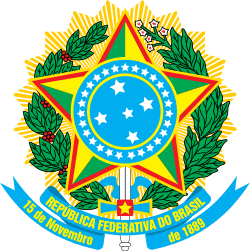 |
| This article is part of a series on the politics and government of Brazil |
|
| Foreign relations |
The Supreme Federal Court (Portuguese: Supremo Tribunal Federal, [suˈpɾẽmu tɾibuˈnaw fedeˈɾaw], abbreviated STF) is the supreme court (court of last resort) of Brazil, serving primarily as the Constitutional Court of the country. It is the highest court of law in Brazil for constitutional issues and its rulings cannot be appealed. On questions involving exclusively non-constitutional issues, regarding federal laws, the highest court is, by rule, the Superior Court of Justice.
Alongside its appeal competence, mostly by the Extraordinary Appeal (Recurso Extraordinário), the Court has a small range of cases of original jurisdiction, including the power of judicial review, judging the constitutionality of laws passed by the National Congress, through a Direct Action of Unconstitutionality (Ação Direta de Inconstitucionalidade, or ADI). There are also other mechanisms for reaching the Court directly, such as the Declaratory Action of Constitutionality (Ação Declaratória de Constitucionalidade, or ADC) and the Direct Action of Unconstitutionality by Omission (Ação Direta de Inconstitucionalidade por Omissão or ADO).
The eleven judges of the court are called Ministers (Ministro), although having no similarity with the government body of ministers. They are appointed by the President and approved by the Senate. There is a mandatory retirement age of 75.
All judicial and administrative meetings of the Supreme Court have been broadcast live on television since 2002. The Court is open for the public to watch the meetings.
In May 2009 The Economist called the Supreme Federal Court "the most overburdened court in the world, thanks to a plethora of rights and privileges entrenched in the country's 1988 constitution (...) till recently the tribunal's decisions did not bind lower courts. The result was a court that is overstretched to the point of mutiny. The Supreme Court received 100,781 cases last year."[1]
History
The court was inaugurated during the colonial era in 1808, the year that the royal family of Portugal (the House of Braganza) arrived in Rio de Janeiro. It was originally called the House of Appeals of Brazil (Casa de Suplicação do Brasil).
The proclamation of the Brazilian Declaration of Independence and the adoption of the Imperial Constitution in 1824 preceded the establishment of the Supreme Court of Justice (Supremo Tribunal de Justiça) in 1829. With the first Constitution of the Republic, the current Court was established.
Although the constitutional norms that regulated the creation of the Court allowed Deodoro da Fonseca, Brazil's first president, to nominate an entirely new Court, the president chose to nominate as the first members of the Supreme Federal Court the ministers who were then serving as members of the predecessor imperial Court.
Two hundred members have served on the Court. The Constitution of 1891 decided that the Court would have 15 members. When Getúlio Vargas came into power, the number of members was reduced to 11. The number was changed to 16 in 1965, but returned to 11 in 1969 and has not changed since. Of all Presidents of Brazil, only one (Café Filho) never nominated a minister.

President of the Court
The President and Vice-president of the Court are elected by their peers for a term of two years by secret ballot. The currently serving President is Carmen Lúcia.
Re-election for a consecutive term is not allowed. By tradition, the members of the Court always elect as president the most senior minister of the Court that has not yet served as President, to avoid politicization of the Court. Therefore, it is known beforehand that the next Presidents of the Court, after Carmen Lúcia, will be, in order, Dias Toffoli and Luiz Fux.
If all members currently sitting on the Court have already served as president, the rotation starts all over again; however, due to the existence of a compulsory retirement age, and the consequent appointment of new ministers to fill those vacancies, it is very rare for the cycle to be completed and restarted, and some ministers are forced to retire before their turn in the presidency arrives, as expected to happen with Teori Zavascki.
According to the same convention, the Court selects as vice-president for a certain term the minister who, according to that tradition, will be selected president in the succeeding term. Also by tradition, the elections of the president and vice-president are never unanimous, there being always one isolated minority vote in each election, as the ministers who are to be elected never cast their votes for themselves; such votes are cast either for the Dean of the Court – its most senior member – or for some other elder minister that the one to be elected admires and wants to pay homage to.
The Chief Justice is also the 4th in the Presidential Succession Line, when the President of Brazil becomes prevented to be in charge, being preceded by the Vice-President, the President of the Chamber of Deputies, and the President of the Federal Senate, as provided in Article 80 of the Brazilian Constitution.[2]
Current members
| Name | Birth | Appointed by | First day | Mandatory retirement | Alma mater |
|---|---|---|---|---|---|
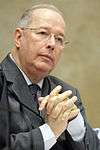 Mello, Celso deCelso de Mello |
November 1, 1945 (age 71) in Tatuí, São Paulo |
Sarney, JoséJosé Sarney | August 17, 1989 (serving for 27 years, 3 months) |
November 1, 2020 | University of São Paulo |
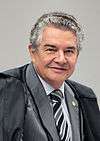 |
July 12, 1946 (age 70) in Rio de Janeiro |
Fernando Collor de Mello | June 13, 1990 (serving for 26 years, 6 months) |
July 12, 2021 | Federal University of Rio de Janeiro |
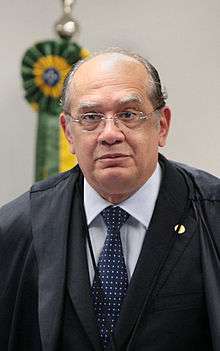 Mendes, GilmarGilmar Mendes |
December 30, 1955 (age 60) in Diamantino, Mato Grosso |
Cardoso, Fernando HenriqueFernando Henrique Cardoso | June 20, 2002 (serving for 14 years, 5 months) |
December 30, 2030 | University of Brasília |
 Lewandowski, RicardoRicardo Lewandowski |
May 11, 1948 (age 68) in Rio de Janeiro |
Lula da Silva, Luiz InácioLuiz Inácio Lula da Silva | March 16, 2006 (serving for 10 years, 8 months) |
May 11, 2023 | University of São Paulo |
 Lúcia, CármenCármen Lúcia (President of the Court) |
April 19, 1954 (age 62) in Montes Claros, Minas Gerais |
Lula da Silva, Luiz InácioLuiz Inácio Lula da Silva | June 21, 2006 (serving for 10 years, 5 months) |
April 19, 2029 | Pontifical Catholic University of Minas Gerais |
 Toffoli, DiasDias Toffoli (Vice President of the Court) |
November 15, 1967 (age 49) in Marília, São Paulo |
Lula da Silva, Luiz InácioLuiz Inácio Lula da Silva | October 23, 2009 (serving for 7 years, 1 month) |
November 15, 2042 | University of São Paulo |
 Fux, LuizLuiz Fux |
April 26, 1953 (age 63) in Rio de Janeiro |
Dilma Rousseff, Dilma Rousseff | March 3, 2011 (serving for 5 years, 9 months) |
April 26, 2028 | Rio de Janeiro State University |
 Weber, RosaRosa Weber |
October 2, 1948 (age 68) in Porto Alegre, Rio Grande do Sul |
Dilma Rousseff, Dilma Rousseff | December 19, 2011 (serving for 4 years, 11 months) |
October 2, 2023 | Federal University of Rio Grande do Sul |
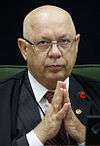 Zavascki, TeoriTeori Zavascki |
August 15, 1948 (age 68) in Faxinal dos Guedes, Santa Catarina |
Dilma Rousseff, Dilma Rousseff | November 29, 2012 (serving for 4 years) |
August 15, 2023 | Federal University of Rio Grande do Sul |
 |
March 15, 1958 (age 58) in Vassouras, Rio de Janeiro |
Dilma Rousseff, Dilma Rousseff | June 26, 2013 (serving for 3 years, 5 months) |
March 15, 2033 | Rio de Janeiro State University |
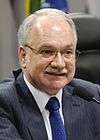 Luiz Edson Fachin |
February 8, 1958 (age 58) in Rondinha, Rio Grande do Sul |
Dilma Rousseff, Dilma Rousseff | June 16, 2015 (serving for 1 year, 5 months) |
February 8, 2033 | Federal University of Paraná |
Gallery
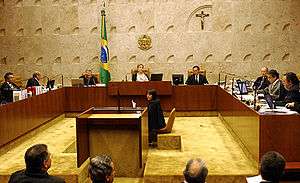 The Supreme Court in session.
The Supreme Court in session.- The Brazilian Prosecutor-General, Rodrigo Janot, is the prosecutor of the Supreme Court and heads the Federal Ministério Público.
 The Brazilian Solicitor-General, Grace Maria Mendonça, is responsible for the legal defense of the federal government in Supreme Court cases, and heads the office of Attorney General at the federal level.
The Brazilian Solicitor-General, Grace Maria Mendonça, is responsible for the legal defense of the federal government in Supreme Court cases, and heads the office of Attorney General at the federal level.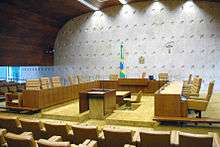 The courtroom of the Supreme Federal Court
The courtroom of the Supreme Federal Court Supreme Federal Court at night
Supreme Federal Court at night.jpg) The Supreme Court lit up in pink for National Breast Cancer Awareness Month on October 1, 2014
The Supreme Court lit up in pink for National Breast Cancer Awareness Month on October 1, 2014
See also
References
- ↑ "Brazil's supreme court: When less is more". The Economist. May 21, 2009.
- ↑ Brazilian Constitution (in Portuguese)
- ↑ STJ Webpage (in Portuguese). Retrieved November 9, 2012
- ↑ STF webpage (in Portuguese). Retrieved December 1st, 2012
- ↑ STF website (in Portuguese). Retrieved November 25, 2012.
External links
Coordinates: 15°48′11″S 47°51′40″W / 15.803°S 47.861°W
